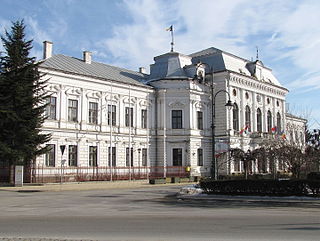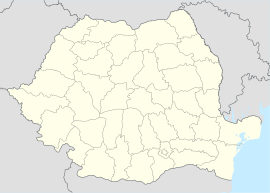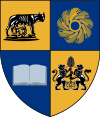
Transylvania is a historical and cultural region in Central Europe, encompassing central Romania. To the east and south its natural border is the Carpathian Mountains and to the west the Apuseni Mountains. Broader definitions of Transylvania also include the western and northwestern Romanian regions of Crișana and Maramureș, and occasionally Banat. Historical Transylvania also includes small parts of neighbouring Western Moldavia and even a small part of south-western neighbouring Bukovina to its north east.

Cluj County is a county of Romania, in Transylvania. Its seat is Cluj-Napoca.

Târgu Mureș is the seat of Mureș County in the historical region of Transylvania, Romania. It is the 16th-largest city in Romania, with 116,033 inhabitants as of the 2021 census. It lies on the Mureș River, the second-longest river in Romania.

Câmpia Turzii is a municipality in Cluj County, Transylvania, Romania, which was formed in 1925 by the union of two villages, Ghiriș (Aranyosgyéres) and Sâncrai (Szentkirály). It was declared a town in 1950 and a city in 1998.

The Arieș is a left tributary of the river Mureș in Transylvania, Romania. It discharges into the Mureș in Gura Arieșului, 11 km (6.8 mi) southwest of Luduș. Its total length is 166 km (103 mi), and its drainage basin area is 3,005 km2 (1,160 sq mi).

Iernut is a town in Mureș County, central Transylvania, Romania. It administers eight villages: Cipău (Maroscsapó), Deag (Marosdég), Lechința (Maroslekence), Oarba de Mureș (Marosorbó), Porumbac (Porumbáktanya), Racameț (Józseftanya), Sălcud (Szélkút), and Sfântu Gheorghe (Csapószentgyörgy). It officially became a town in 1989, as a result of the Romanian rural systematization program.

Transylvania is a historical region in central and northwestern Romania. It was under the rule of the Agathyrsi, part of the Dacian Kingdom, Roman Dacia (106–271), the Goths, the Hunnic Empire, the Kingdom of the Gepids, the Avar Khaganate, the Slavs, and the 9th century First Bulgarian Empire. During the late 9th century, Transylvania was part of the Hungarian conquest, and the family of Gyula II of the seven chieftains of the Hungarians ruled Transylvania in the 10th century. King Stephen I of Hungary asserted his claim to rule all lands dominated by Hungarian lords, and he personally led his army against his maternal uncle Gyula III. Transylvania became part of the Kingdom of Hungary in 1002, and it belonged to the Lands of the Hungarian Crown until 1920.

Étienne Hajdú was a Hungarian-born French sculptor of Jewish descent. After emigration to Paris in the 1930s, he became part of the Hungarian circle of artists and writers. He fought in the French Resistance during World War II.

The Reformed Church in Romania is a Calvinist denomination and the largest Protestant church in Romania. The majority of its followers are of Hungarian ethnicity and Hungarian is the main church language. The large majority of the Church's parishes are in Transylvania; according to the 2021 census, 495,380 people or 2.6% of the total population belong to the Reformed Church. About 95% of the members were of Hungarian ethnicity.
The Edict of Torda was a decree that authorized local communities to freely elect their preachers in the Eastern Hungarian Kingdom of John Sigismund Zápolya. The delegates of the Three Nations of Transylvania – the Hungarian nobles, Transylvanian Saxons, and Székelys – adopted it at the request of the monarch's Antitrinitarian court preacher, Ferenc Dávid, in Torda on 28 January 1568. Though it did not acknowledge an individual's right to religious freedom, in sanctioning the existence of a radical Christian religion in a European state, the decree was an unprecedented act of religious tolerance.

Rimetea is a commune located in Alba County, Transylvania, Romania. It is composed of two villages, Colțești and Rimetea. A former mining town, today it is known as the location of the Piatra Secuiului mountain.

János Kemény was a Hungarian aristocrat, writer and prince of Transylvania.

The Hungarian minority of Romania is the largest ethnic minority in Romania. As per the 2021 Romanian census, 1,002,151 people declared themselves Hungarian, while 1,038,806 people stated that Hungarian was their mother tongue.

The A3 motorway is a partially built motorway in Romania, planned to connect Bucharest with the Transylvania region and the north-western part of the country. It will be 596 km long and will run along the route: Ploiești, Brașov, Făgăraș, Sighișoara, Târgu Mureș, Cluj-Napoca, Zalău and Oradea, connecting with Hungary's M4 motorway near Borș.

Aranyos seat was the seat of the Transylvanian Székelys living in the Valley of the Arieș River.

The Transylvanian Diet was an important legislative, administrative and judicial body of the Principality of Transylvania between 1570 and 1867. The general assemblies of the Transylvanian noblemen and the joint assemblies of the representatives of the "Three Nations of Transylvania"—the noblemen, Székelys and Saxons—gave rise to its development. After the disintegration of the medieval Kingdom of Hungary in 1541, delegates from the counties of the eastern and northeastern territories of Hungary proper also attained the Transylvanian Diet, transforming it into a legal successor of the medieval Diets of Hungary.

The following detailed sequence of events covers the timeline of Cluj-Napoca, a city in Transylvania, Romania.

Turda County was a county in the Kingdom of Romania, as successor to Torda-Aranyos County in Austria-Hungary. Its capital was Turda.
János Gerendi was a Transylvanian politician who supported radical theological views. He "was in contact with nearly all the prominent representatives of the radical Antitrinitarians" after 1570. His followers, who regarded Saturday as the day of rest, but did not obey all the Old Testament laws, were known as "Gerendists". He accepted atheist philosophy from the late 1580s.

































